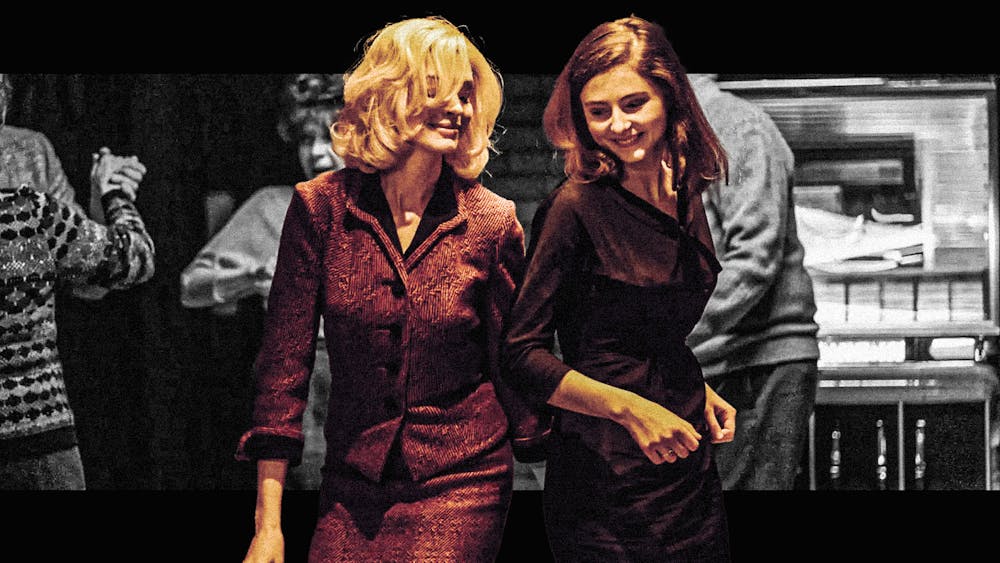The titular Eileen, played by Thomasin McKenzie in the 2023 film Eileen, captivated the audiences even before the film’s inception. Adapting from Ottessa Moshfegh’s Booker Prize shortlisted novel, the director William Oldroyd was instantly fascinated by the complexity of the character of Eileen when he read it for the first time, and immediately knew he wanted to work with Moshfegh and screenwriter Luke Goebel to bring the story to the big screen.
The process of adapting a novel to film can be confusing, as the techniques of developing beat, tone and atmosphere differ greatly across mediums. When talking about the adaptation of Eileen, Moshfegh emphasizes reframing her mindset to view the film as a separate project. “It's funny to think about what exists in a book that didn't exist in the film, because to me, they’re two very separate projects.” She accentuates, “I never felt like there were pieces of the novel that were getting thrown away, the novel definitely existed. We weren't going to change it. But we did want to tell a really succinct and focused and suspenseful story on screen.”
It is evident that certain structures of storytelling from the novel have been altered: Instead of slowly revealing Eileen’s loneliness and psyche through description, the opening shot of the film directly portrays Eileen pleasuring herself in response to seeing a couple several meters away. This shot, among other jarring fantasy transitions in the middle of the otherwise regular scenes, swiftly set the stage on Eileen’s state of mind before Anne Hathaway as the sophisticated Rebecca entered the film.
However, despite these specific changes, the succinct structure of a two–hour film nonetheless prevents a well–established foundation on who Eileen is. While the aforementioned scenes quickly establish Eileen’s loneliness and desire for more, it would be more effective to see how those scenes could be more tailored and cohesive to reflect Eileen’s desires. After all, all I know of Eileen is that she isn’t right in the head, but whether her motivation is freedom from responsibility over her drunken father, being able to be in an intense, intimate relationship or just general depression is unclear. By mashing them all together to quickly paint her as troubled, Eileen potentially frustrates a clear character arc for the audience to follow through.
With the introduction of Rebecca, Hathaway’s acting quickly injects liveliness into the world of Eileen. Eileen is trapped in a bleak-colored 1960s Massachusetts as a secretary at a juvenile facility. Her only source of excitement is her wild fantasies. However, promptly after Rebecca’s sudden appearance as a psychologist at the facility, men begin to surround Eileen. She swaps out her grayish cardigans and skirts that swallow her whole for her late mother’s stylish clothes, and slowly builds up the courage to act in her interests. In essence, Eileen becomes attracted to and dependent on Rebecca's attention and life.
This dependence is especially pronounced by the film’s color scheme and tonality whenever Rebecca is present. Warm orange hues, jewel tones and rich music seep onto the screen, pushing out the 1960’s themed score and drab colors, thanks to in no small part the work of Oldroyd with the editor Nick Emerson. Goebel praises that the film “just kept getting better and better and better in the editing, which was just such a surprise to see after we had completely handed over the the film…and then to see it, even after the actors had done their work, just keep improving through the choices of Will and Nick made together.”
When questioned on what the film sought to explore with the complex dynamic between Rebecca and Eileen that is laced with queerness, Moshfegh explains they “were all very interested in the gray area between platonic and romantic. Real and imaginary, there were a lot of blurred lines. The discomfort was something I think we really wanted to highlight, especially in terms of how that built up the tension, which we wanted to use to make the twist really exciting.”
Ultimately, the compellingness of the climax is largely dependent on Hathaway’s alluring performance. Her mannerisms, quirks, and essence keep the audience rapt. Is Rebecca a dramatized illusion of a real person fabricated by Eileen due to her desperation? Or is she a real individual within the story who, due to Hathaway’s superb acting, never feels like a caricature of a stylish, assertive woman? This is the exploration of real and imaginary that shines throughout the film.
Thus, the individual parts and varying aspects of the development and creation of this film have their merits. However, after the climax came and went, and the final scene faded into the credits, the film’s plotlines and exploration of characters don’t seem to build up to a greater narrative on the effect and relationship of the two. Instead, the audience is left with a series of dramatic events, two interesting characters that the audience is never given the opportunity to truly know over the course of the film, and a crime drama left unresolved. Yet, after all, the general mystery and irreducibility can be the whole point of the film?







